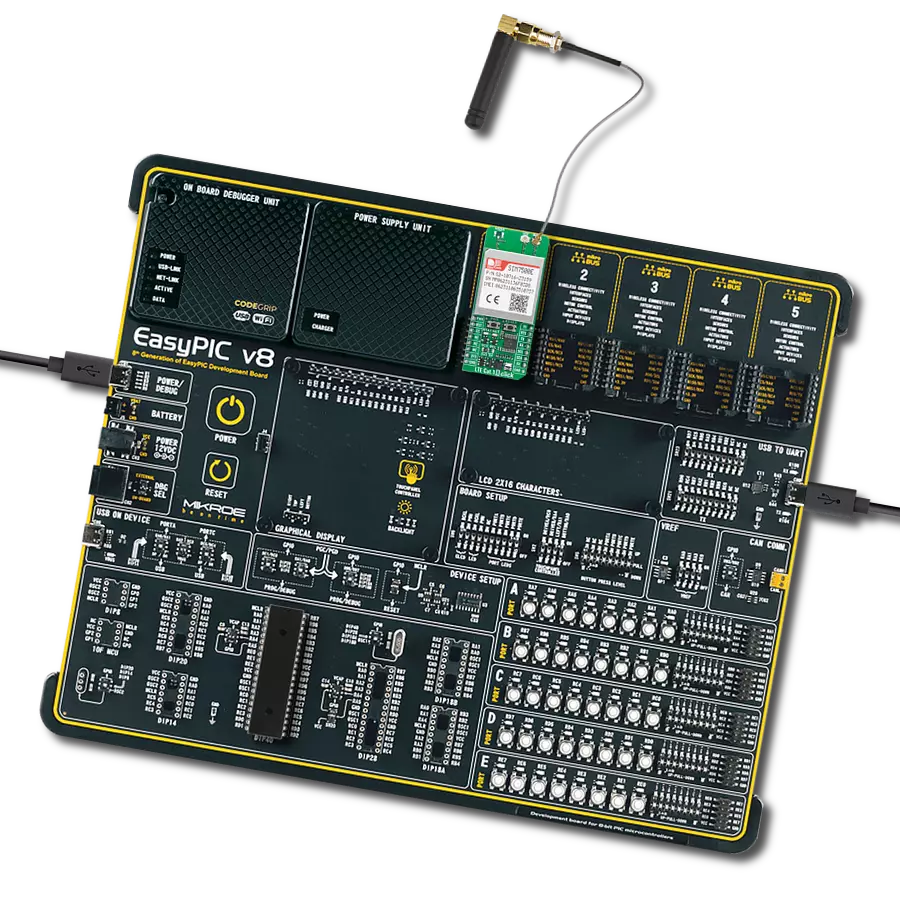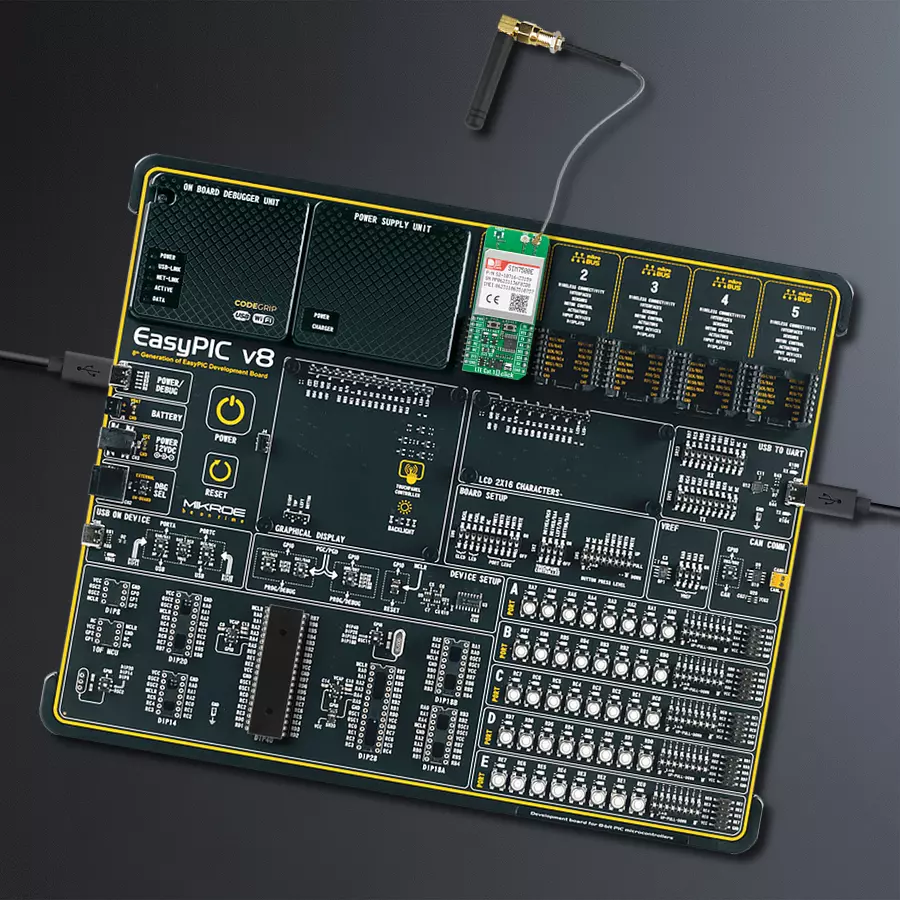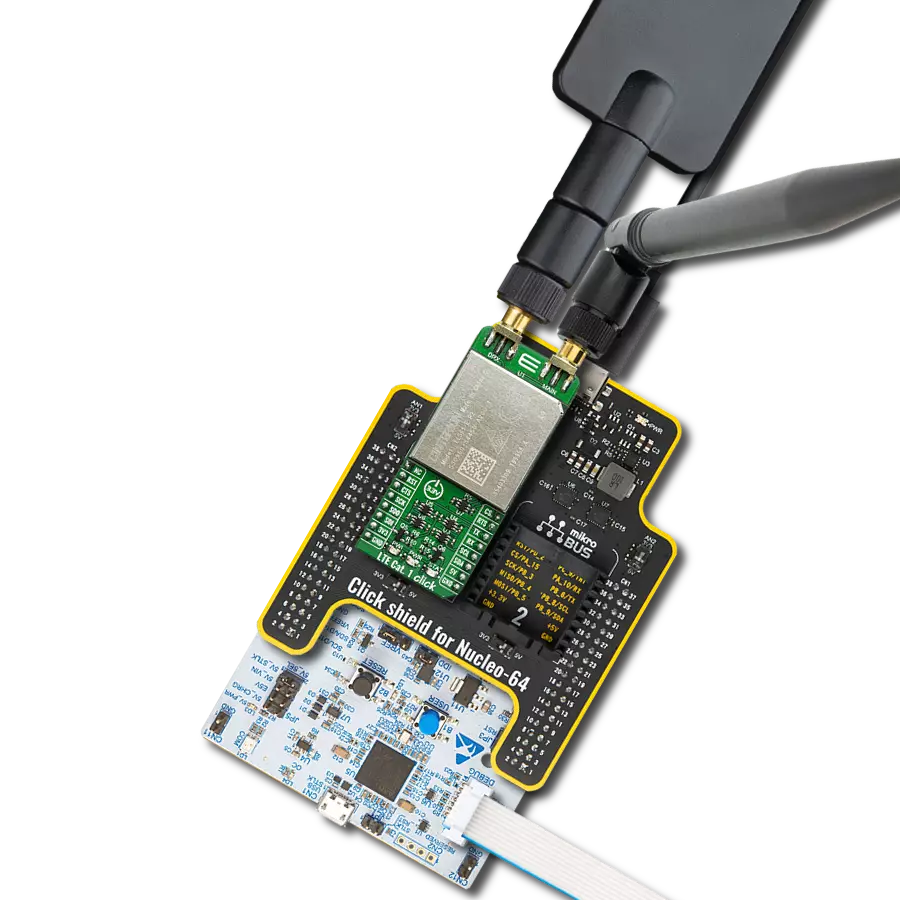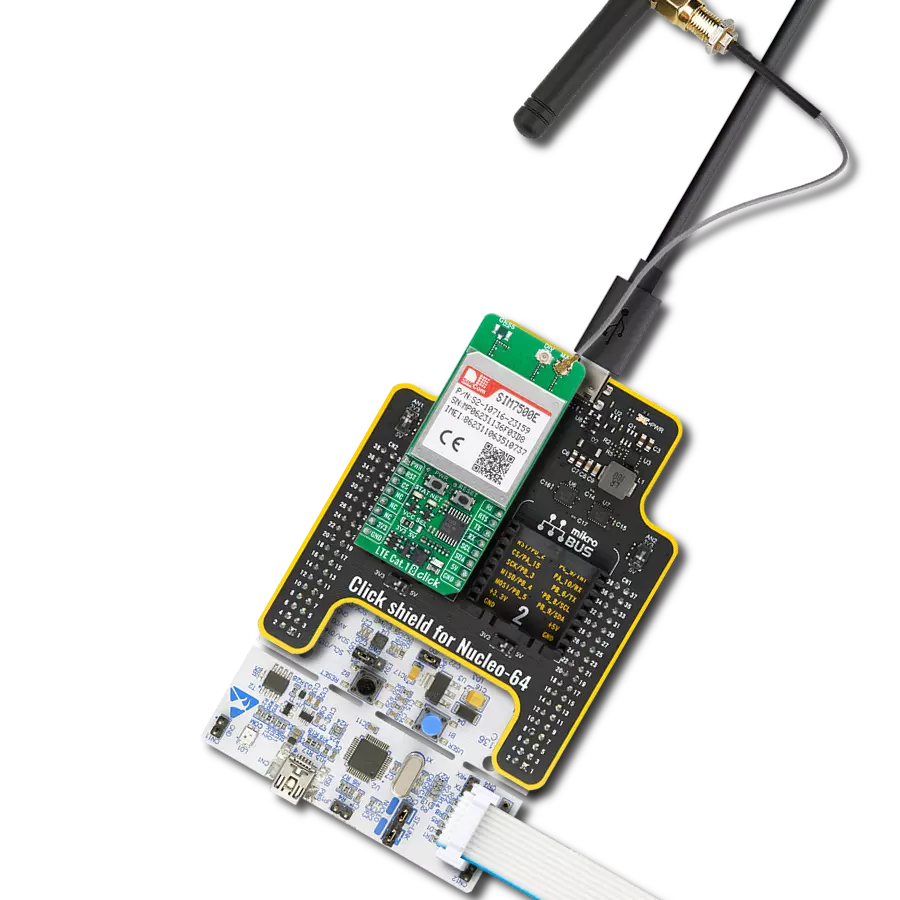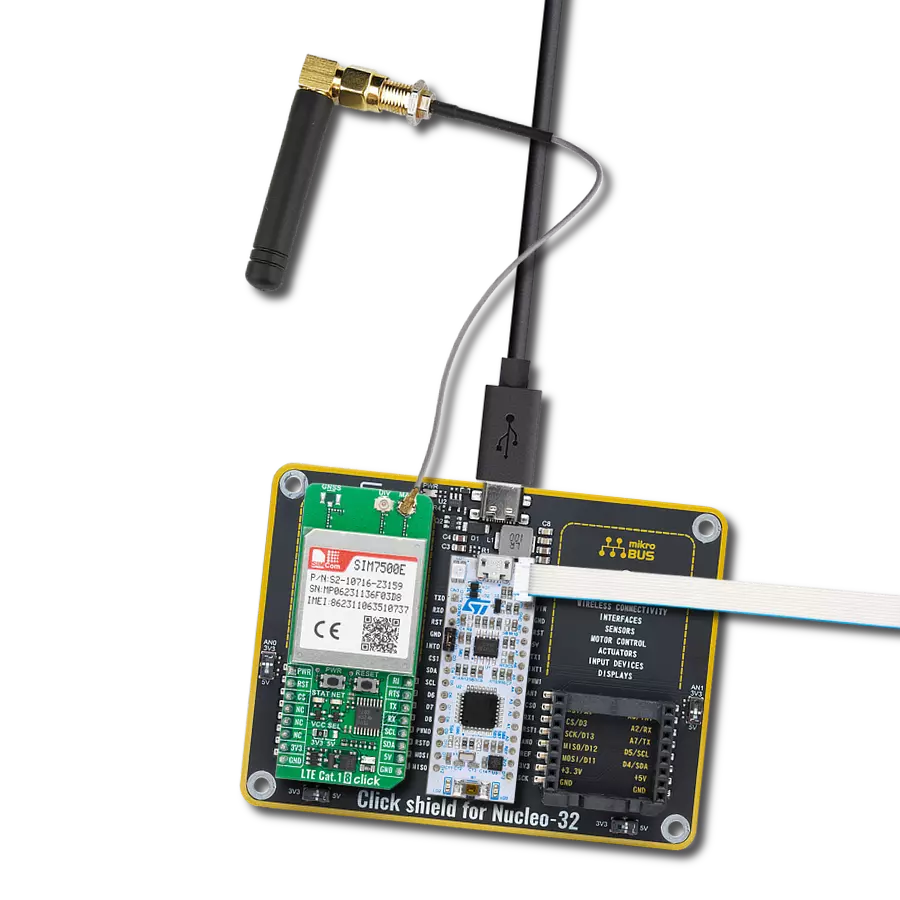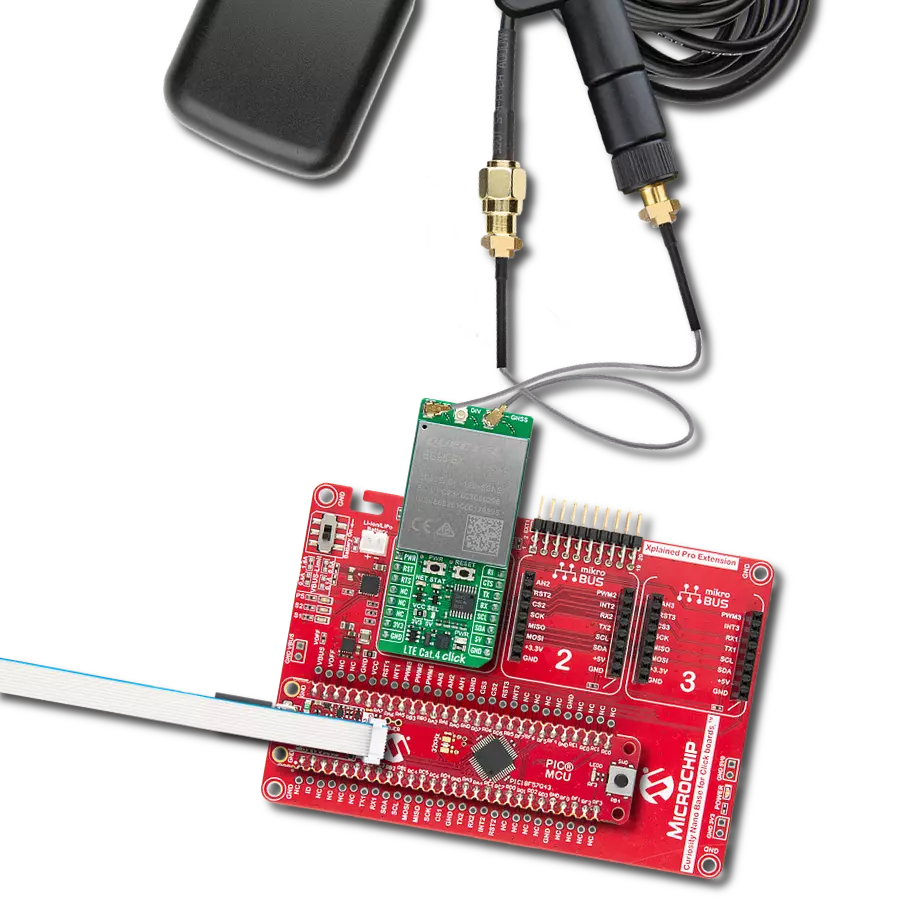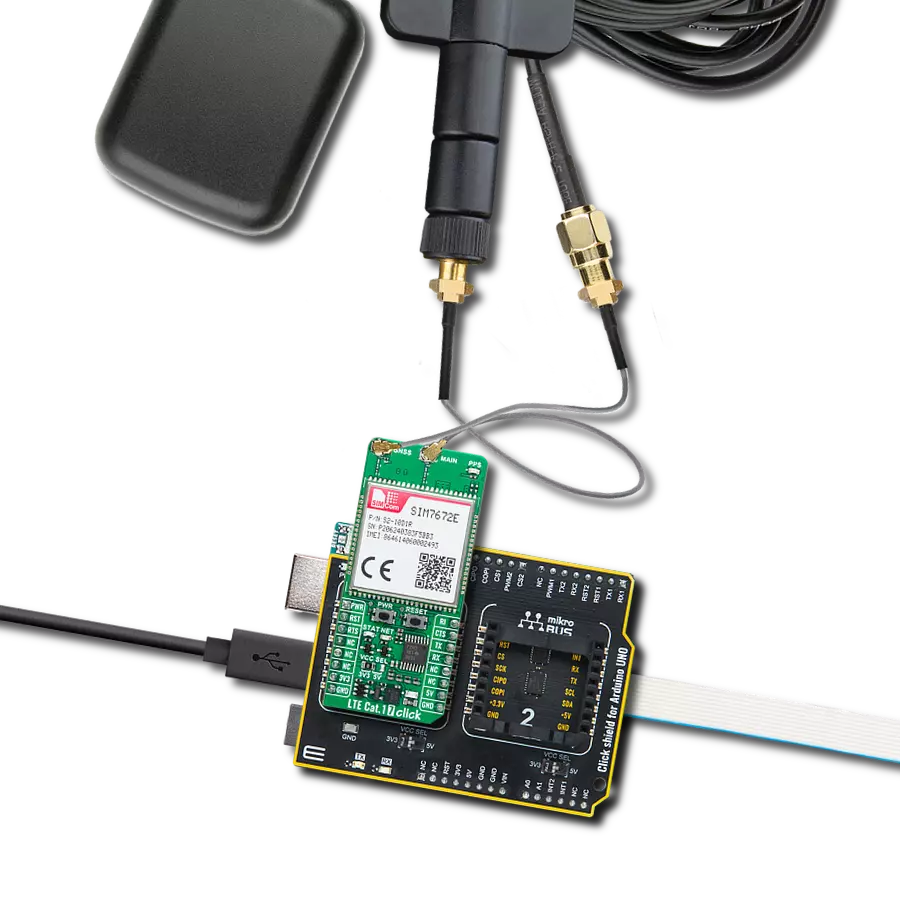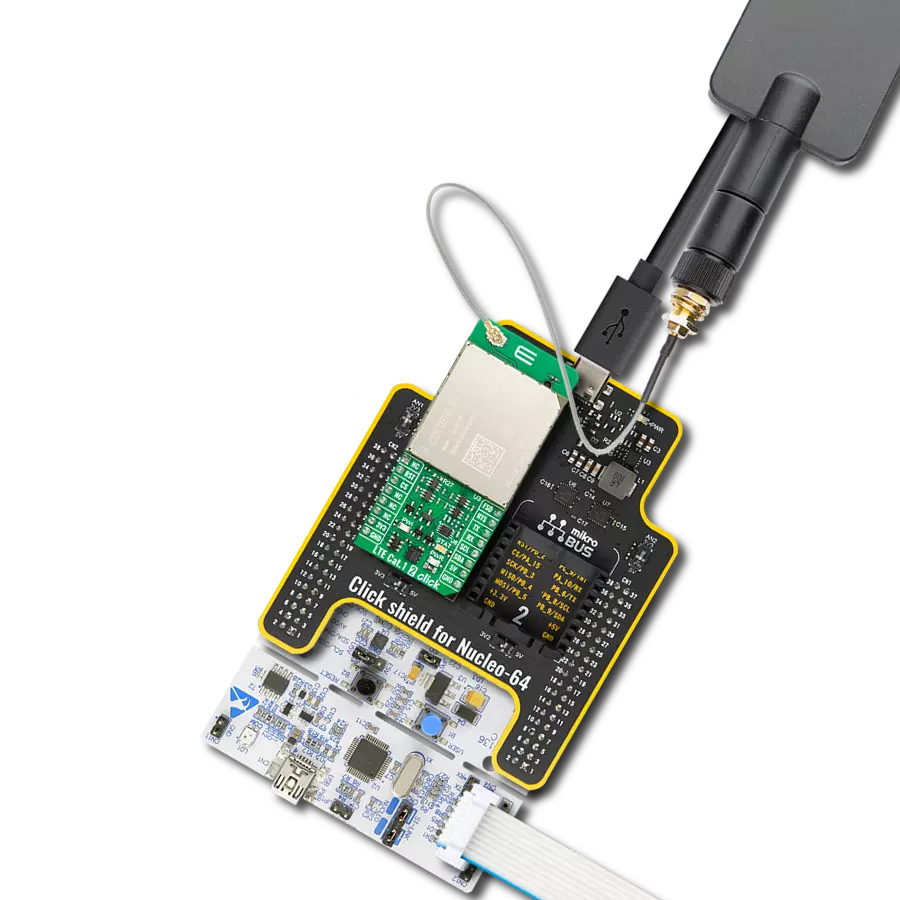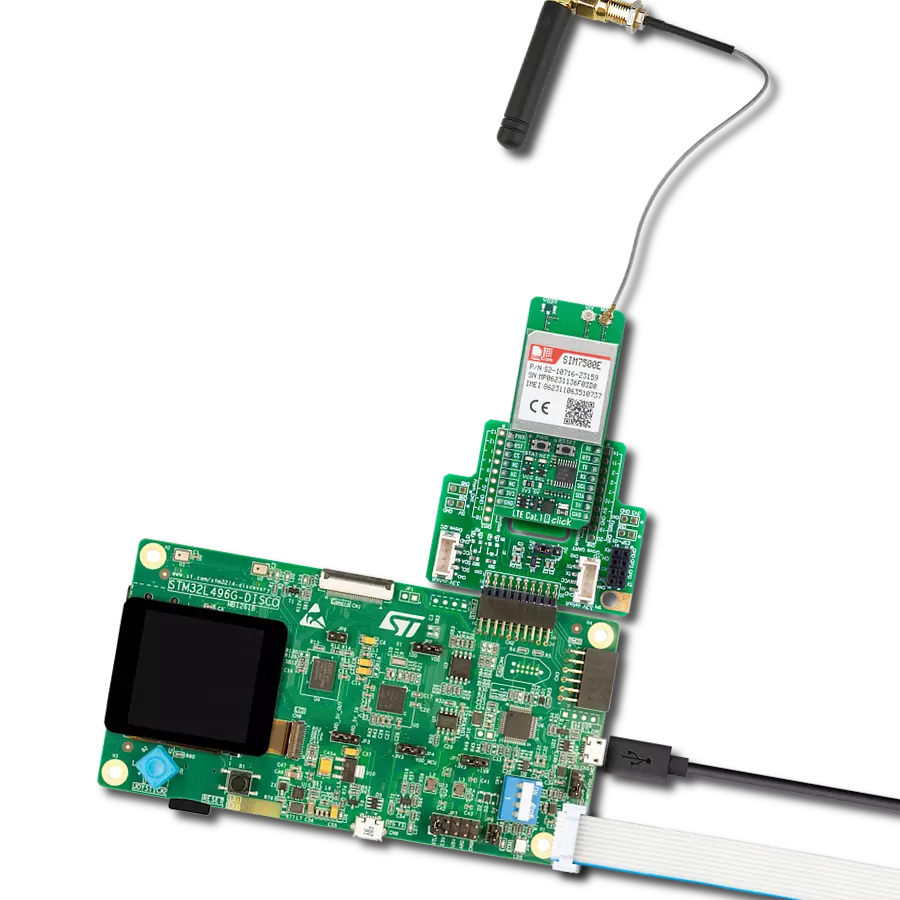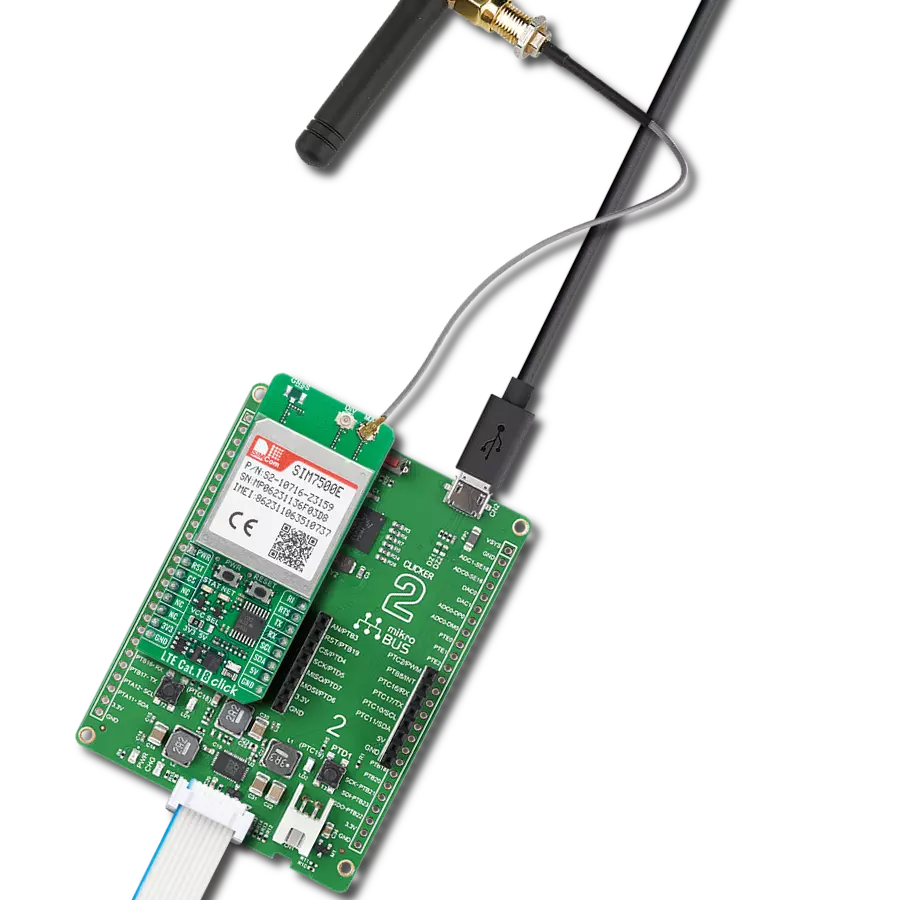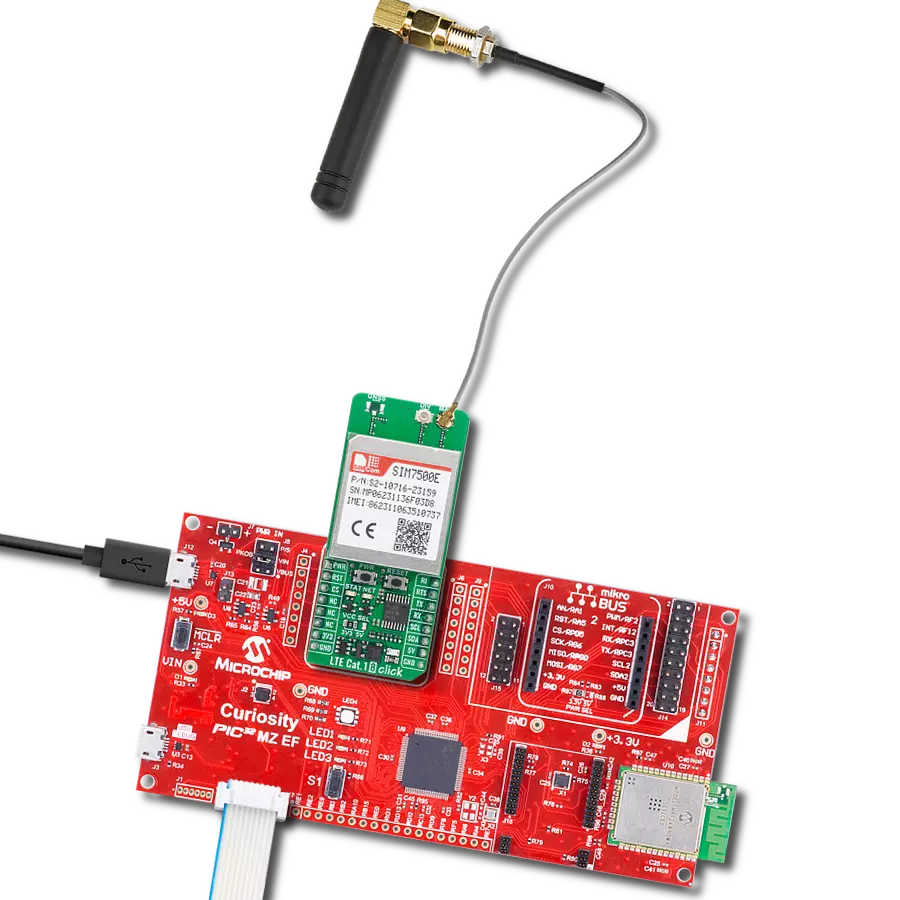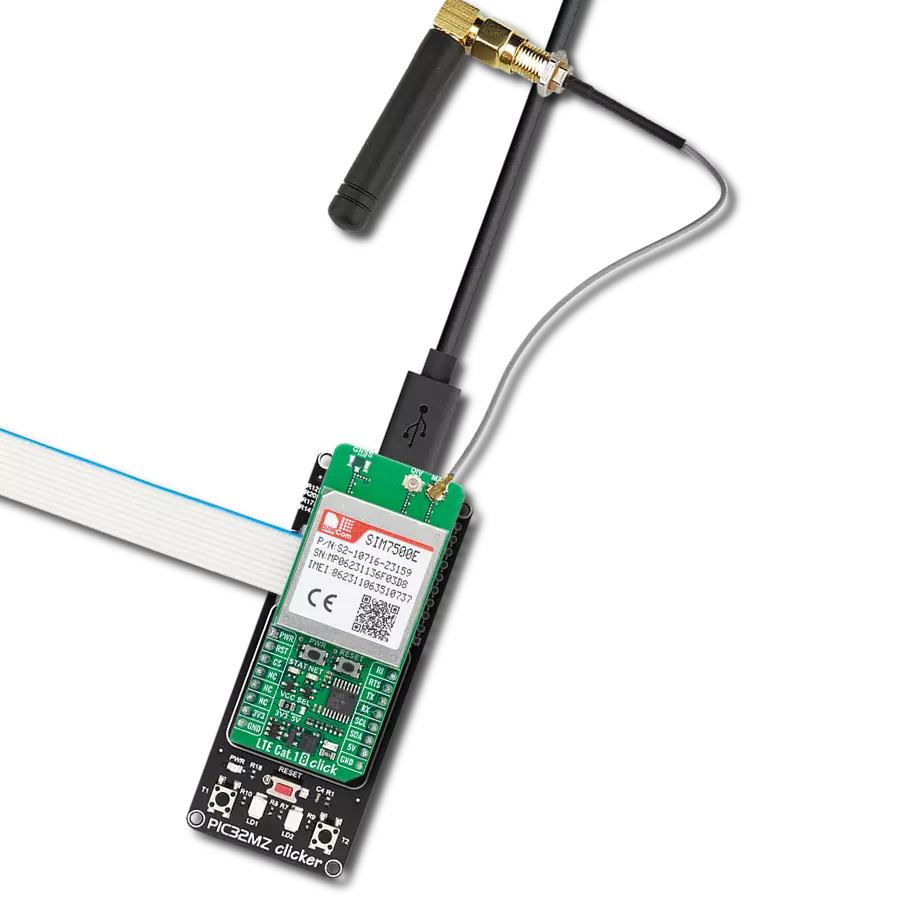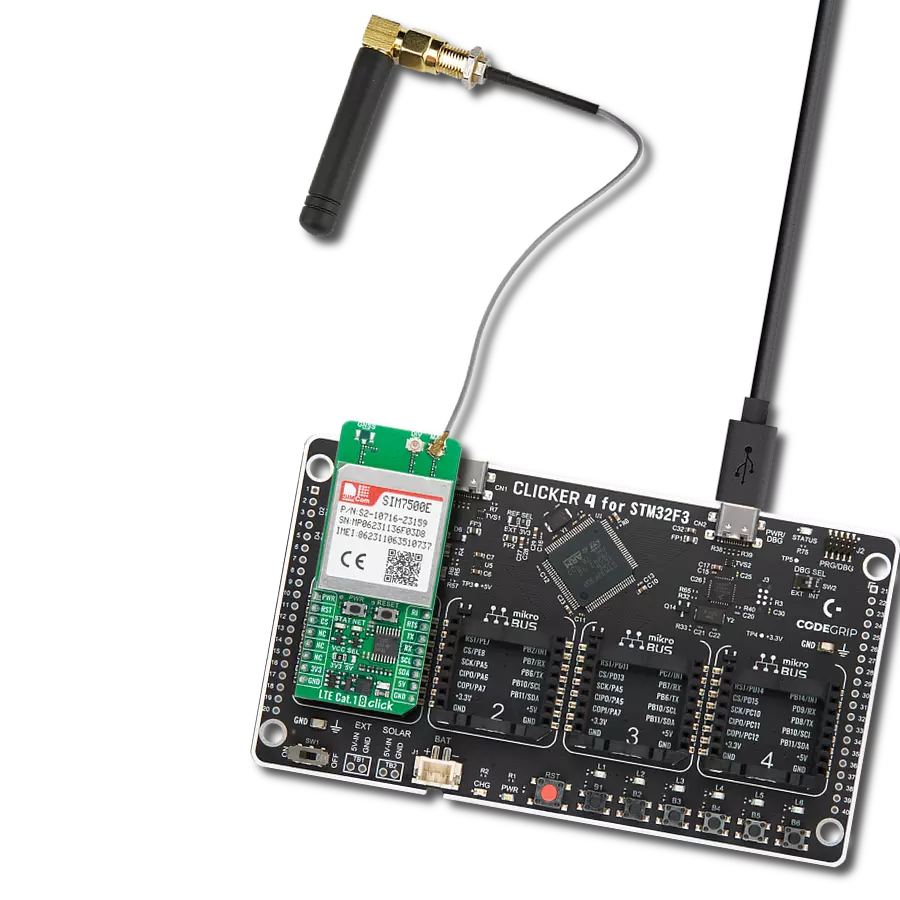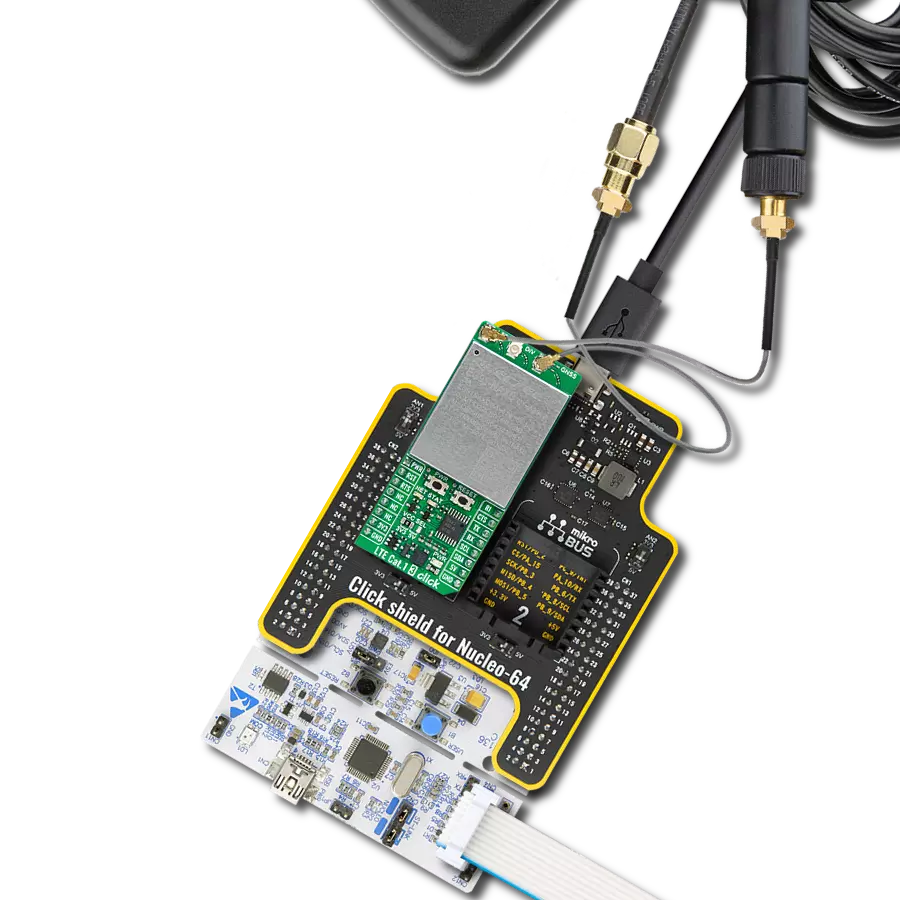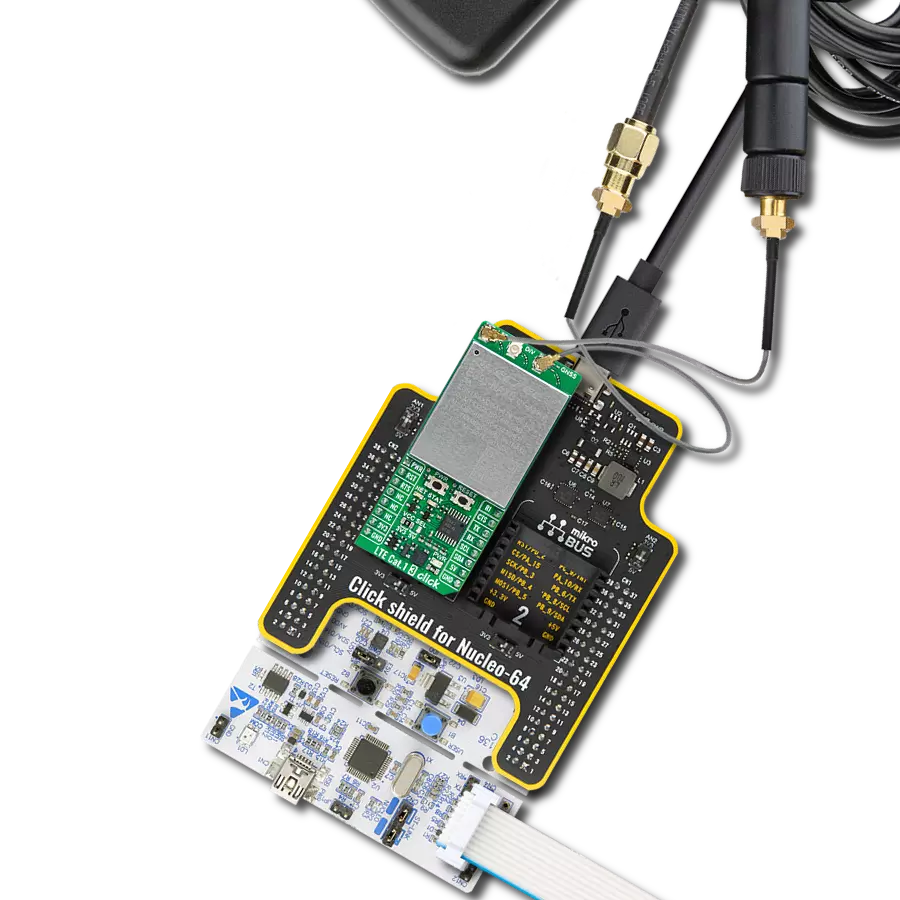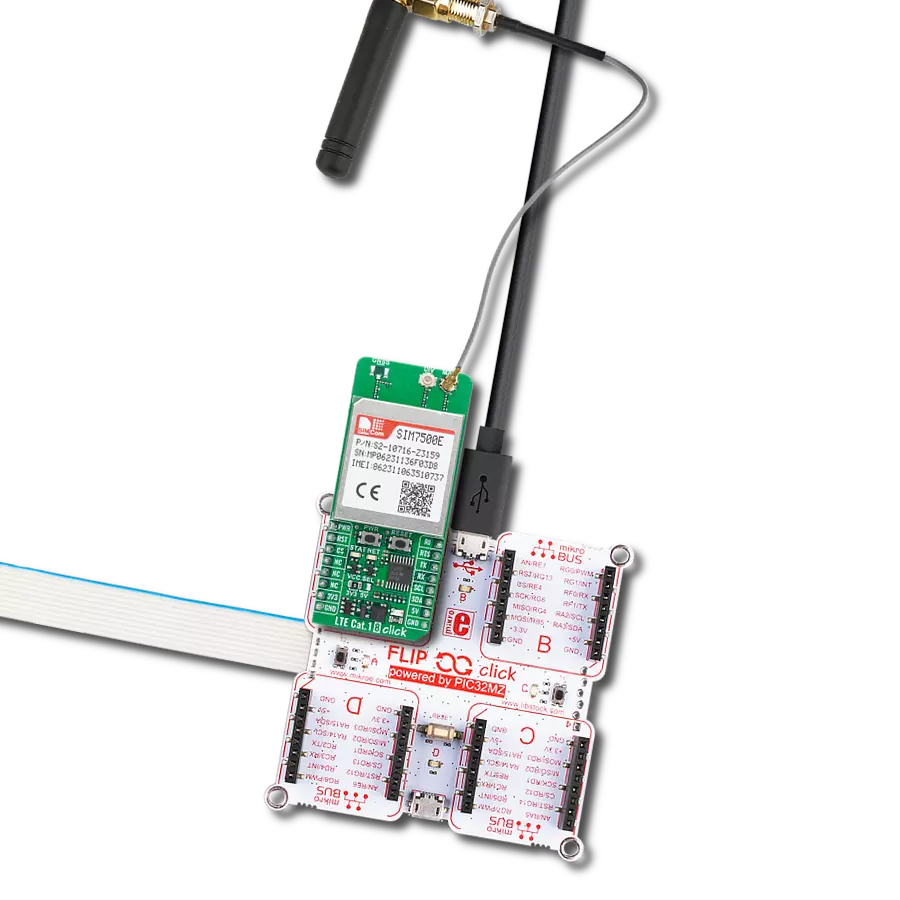可靠的 LTE Cat 1 连接,专为车队远程信息处理、工业路由器和远程诊断应用而设计
A
A
硬件概览
它是如何工作的?
LTE Cat.1 8 Click 是一款基于 SIMCom 的 SIM7500E 模块的紧凑型扩展板,该模块支持 LTE Cat 1 通信,并兼容多种无线标准,包括 LTE-TDD、LTE-FDD、HSPA+、GSM、GPRS 和 EDGE。其对 LTE、UMTS 和 GSM 网络的兼容性确保了全球广泛覆盖,使其非常适合需要跨地区稳定移动连接的应用。频段支持包括 LTE-FDD 的 B1、B3、B7、B8 和 B20,以及 GSM 的 900 和 1800 MHz,设备可灵活适应多种运营商网络。该模块专为远程信息处理、远程监控、CPE 系统、工业路由器和远程诊断等 IoT 场景而设计,是开发者在嵌入式系统中寻求稳定多功能移动通信的可靠平台。SIM7500E 支持最高 10Mbps 的下载速率和 5Mbps 的上传速率,数据吞吐均衡,适用于多种物联网用例。除了强大的蜂窝通信能力外,该模块还具备集成的多星座 GNSS 功能,提供高精度定位能力(当前此 Click 板未启用 GNSS,相关元件未焊接)。SIM7500E 模块集成了多种嵌入式网络协议,包括 TCP/IP、IPv4、IPv6、Multi-PDP、FTP、
FTPS、HTTP、HTTPS 和 DNS,提供安全灵活的数据传输解决方案。模块支持 Windows、Linux 和 Android 等主流操作系统的 USB 驱动,可轻松集成到各种开发环境中。SIM7500E 与主控 MCU 通过 UART 接口通信,采用标准的 UART RX 和 TX 引脚,并配有硬件流控引脚(CTS、RTS、RI),默认通信速率为 115200bps,支持通过 AT 指令进行数据交互。该 Click 板配有 USB Type C 接口,用于供电和数据传输,符合 USB 2.0 规范(仅限从设备模式),还提供 I2C 接口,仅用于读取和写入板载 I2C 外设的寄存器。板背面设有 BOOT 开关,用于固件升级(0 为正常运行,1 为 USB 下载),以及 FLIGHT 开关,用于在正常模式(1)与飞行模式(0)之间切换。板上集成了 PWR 按钮用于开启或关闭模块电源,RESET 按钮用于快速复位模块,这些功能也可通过 mikroBUS 引脚 PWR 和 RST 进行数字控制,同时提供测试点以方便调试与测试。两个视觉指示灯用于显示模块状态:红色 NET 指示灯显示网络连接状
态,常亮表示正在搜索网络,200ms 闪烁表示正在进行数据传输或已注册到 4G 网络,800ms 闪烁表示已注册到 2G 或 3G 网络,熄灭表示模块关闭或处于休眠状态;黄色 STAT 指示灯表示模块的电源状态,模块开启时常亮,关闭时熄灭。该板配有三个 u.FL 接口,分别用于连接 LTE 主天线、辅助分集天线以及可选的 GNSS 天线。用户可通过 GNSS ANT 跳线选择为 GNSS 天线提供 3.3V 或 5V 电源,但请注意此 Click 板当前不支持 GNSS 功能,因此 GNSS 相关元件未焊接。此外,该板还配有一个 micro SIM 卡座,兼容 1.8V 和 3.0V 的 uSIM 卡,便于用户根据实际需求选择合适的运营商。该 Click 板支持 3.3V 和 5V 逻辑电平,通过 VCC SEL 跳线进行选择。由于 SIM7500E 模块工作电压为 3.8V,因此板载集成了 TXB0106 和 PCA9306 电平转换器,确保不同电压主控 MCU 均能实现正确的通信。该 Click 板还附带配套函数库和示例代码,可供开发者参考与二次开发使用。
功能概述
开发板
EasyPIC v8 是一款专为快速开发嵌入式应用的需求而特别设计的开发板。它支持许多高引脚计数的8位PIC微控制器,来自Microchip,无论它们的引脚数量如何,并且具有一系列独特功能,例如首次集成的调试器/程序员。开发板布局合理,设计周到,使得最终用户可以在一个地方找到所有必要的元素,如开关、按钮、指示灯、连接器等。得益于创新的制造技术,EasyPIC v8 提供了流畅而沉浸式的工作体验,允许在任何情况下、任何地方、任何时候都能访问。
EasyPIC v8 开发板的每个部分都包含了使同一板块运行最高效的必要组件。除了先进的集成CODEGRIP程 序/调试模块,该模块提供许多有价值的编程/调试选项和与Mikroe软件环境的无缝集成外,该板还包括一个干净且调节过的开发板电源供应模块。它可以使用广泛的外部电源,包括电池、外部12V电源供应和通过USB Type-C(USB-C)连接器的电源。通信选项如USB-UART、USB DEVICE和CAN也包括在内,包括 广受好评的mikroBUS™标准、两种显示选项(图形和
基于字符的LCD)和几种不同的DIP插座。这些插座覆盖了从最小的只有八个至四十个引脚的8位PIC MCU的广泛范围。EasyPIC v8 是Mikroe快速开发生态系统的一个组成部分。它由Mikroe软件工具原生支持,得益于大量不同的Click板™(超过一千块板),其数量每天都在增长,它涵盖了原型制作和开发的许多方面。
微控制器概述
MCU卡片 / MCU
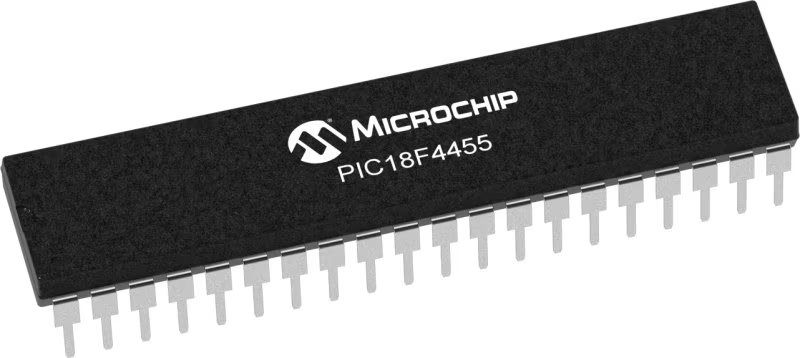
建筑
PIC
MCU 内存 (KB)
24
硅供应商
Microchip
引脚数
40
RAM (字节)
2048
你完善了我!
配件
Rubber Antenna GSM/GPRS Right Angle 是我们广泛产品线中所有 GSM Click boards™ 的理想伴侣。这款专用天线经过设计,旨在优化您的无线连接,具有令人印象深刻的功能。其宽频率范围覆盖 824-894/1710-1990MHz 或 890-960/1710-1890MHz,能够处理各种频段,确保无缝可靠的连接。天线具有 50 欧姆阻抗和 2dB 增益,增强了信号接收和传输。其 70/180MHz 带宽为各种应用提供了灵活性。垂直极化进一步提升了其性能。该天线的最大输入功率容量为 50W,确保即使在苛刻条件下也能实现强大的通信。天线长度仅为 50mm,配有 SMA 公头连接器,Rubber Antenna GSM/GPRS Right Angle 是一款多功能且紧凑的无线通信解决方案,能够满足您的各种无线通信需求。
使用的MCU引脚
mikroBUS™映射器
“仔细看看!”
Click board™ 原理图

一步一步来
项目组装
实时跟踪您的结果
应用程序输出
1. 应用程序输出 - 在调试模式下,“应用程序输出”窗口支持实时数据监控,直接提供执行结果的可视化。请按照提供的教程正确配置环境,以确保数据正确显示。

2. UART 终端 - 使用UART Terminal通过USB to UART converter监视数据传输,实现Click board™与开发系统之间的直接通信。请根据项目需求配置波特率和其他串行设置,以确保正常运行。有关分步设置说明,请参考提供的教程。

3. Plot 输出 - Plot功能提供了一种强大的方式来可视化实时传感器数据,使趋势分析、调试和多个数据点的对比变得更加直观。要正确设置,请按照提供的教程,其中包含使用Plot功能显示Click board™读数的分步示例。在代码中使用Plot功能时,请使用以下函数:plot(insert_graph_name, variable_name);。这是一个通用格式,用户需要将“insert_graph_name”替换为实际图表名称,并将“variable_name”替换为要显示的参数。

软件支持
库描述
LTE Cat.1 8 Click 演示应用程序使用 NECTO Studio开发,确保与 mikroSDK 的开源库和工具兼容。该演示设计为即插即用,可与所有具有 mikroBUS™ 插座的 开发板、入门板和 mikromedia 板完全兼容,用于快速实现和测试。
示例描述
此示例展示了 LTE Cat.1 8 Click 板连接至网络并使用标准 "AT" 指令发送 SMS 或 TCP/UDP 消息的能力。
关键功能:
ltecat18_cfg_setup- 初始化 Click 配置结构为默认初始值。ltecat18_init- 初始化该 Click 板所需的所有引脚和外设。ltecat18_set_sim_apn- 设置 SIM 卡的 APN 参数。ltecat18_send_sms_text- 向指定手机号发送短信。ltecat18_cmd_set- 设置 Click 模块中指定 AT 指令的值。
应用初始化
初始化驱动程序和日志记录器。
应用任务
应用任务分为多个阶段:
LTECAT18_POWER_UP:启动设备,执行设备出厂重置并读取系统信息。LTECAT18_CONFIG_CONNECTION:配置设备以连接到网络。LTECAT18_CHECK_CONNECTION:通过 CEREG 指令等待网络注册完成,并检查信号质量报告。LTECAT18_CONFIG_EXAMPLE:配置设备以执行选定的示例任务。LTECAT18_EXAMPLE:根据所选演示示例,发送 SMS 消息(PDU 或 TXT 模式)或 TCP/UDP 消息。默认选择 TCP/UDP 示例。
开源
代码示例
完整的应用程序代码和一个现成的项目可以通过NECTO Studio包管理器直接安装到NECTO Studio。 应用程序代码也可以在MIKROE的GitHub账户中找到。
/*!
* @file main.c
* @brief LTE Cat.1 8 Click Example.
*
* # Description
* Application example shows device capability of connecting to the network and
* sending SMS or TCP/UDP messages using standard "AT" commands.
*
* The demo application is composed of two sections :
*
* ## Application Init
* Initializes the driver and logger.
*
* ## Application Task
* Application task is split in few stages:
* - LTECAT18_POWER_UP:
* Powers up the device, performs a device factory reset and reads system information.
*
* - LTECAT18_CONFIG_CONNECTION:
* Sets configuration to device to be able to connect to the network.
*
* - LTECAT18_CHECK_CONNECTION:
* Waits for the network registration indicated via CREG command and then checks the signal quality report.
*
* - LTECAT18_CONFIG_EXAMPLE:
* Configures device for the selected example.
*
* - LTECAT18_EXAMPLE:
* Depending on the selected demo example, it sends an SMS message (in PDU or TXT mode) or TCP/UDP message.
*
* By default, the TCP/UDP example is selected.
*
* ## Additional Function
* - static void ltecat18_clear_app_buf ( void )
* - static void ltecat18_log_app_buf ( void )
* - static err_t ltecat18_process ( ltecat18_t *ctx )
* - static err_t ltecat18_read_response ( ltecat18_t *ctx, uint8_t *rsp )
* - static err_t ltecat18_power_up ( ltecat18_t *ctx )
* - static err_t ltecat18_config_connection ( ltecat18_t *ctx )
* - static err_t ltecat18_check_connection ( ltecat18_t *ctx )
* - static err_t ltecat18_config_example ( ltecat18_t *ctx )
* - static err_t ltecat18_example ( ltecat18_t *ctx )
*
* @note
* In order for the examples to work, user needs to set the APN and SMSC (SMS PDU mode only)
* of entered SIM card as well as the phone number (SMS mode only) to which he wants to send an SMS.
* Enter valid values for the following macros: SIM_APN, SIM_SMSC and PHONE_NUMBER.
* Example:
SIM_APN "internet"
SIM_SMSC "+381610401"
PHONE_NUMBER "+381659999999"
*
* @author Stefan Filipovic
*
*/
#include "board.h"
#include "log.h"
#include "ltecat18.h"
#include "conversions.h"
// Example selection macros
#define EXAMPLE_TCP_UDP 0 // Example of sending messages to a TCP/UDP echo server
#define EXAMPLE_SMS 1 // Example of sending SMS to a phone number
#define DEMO_EXAMPLE EXAMPLE_TCP_UDP // Example selection macro
// SIM APN config
#define SIM_APN "internet" // Set valid SIM APN
// SMS example parameters
#define SIM_SMSC "" // Set valid SMS Service Center Address - only in SMS PDU mode
#define PHONE_NUMBER "" // Set Phone number to message
#define SMS_MODE "1" // SMS mode: "0" - PDU, "1" - TXT
// TCP/UDP example parameters
#define REMOTE_IP "77.46.162.162" // TCP/UDP echo server IP address
#define REMOTE_PORT "51111" // TCP/UDP echo server port
// Message content
#define MESSAGE_CONTENT "LTE Cat.1 8 Click board - demo example."
// Application buffer size
#define APP_BUFFER_SIZE 256
#define PROCESS_BUFFER_SIZE 256
/**
* @brief Example states.
* @details Predefined enum values for application example state.
*/
typedef enum
{
LTECAT18_POWER_UP = 1,
LTECAT18_CONFIG_CONNECTION,
LTECAT18_CHECK_CONNECTION,
LTECAT18_CONFIG_EXAMPLE,
LTECAT18_EXAMPLE
} ltecat18_app_state_t;
/**
* @brief Application example variables.
* @details Variables used in application example.
*/
static uint8_t app_buf[ APP_BUFFER_SIZE ] = { 0 };
static int32_t app_buf_len = 0;
static ltecat18_app_state_t app_state = LTECAT18_POWER_UP;
static ltecat18_t ltecat18;
static log_t logger;
/**
* @brief LTE Cat.1 8 clearing application buffer.
* @details This function clears memory of application buffer and reset its length.
* @note None.
*/
static void ltecat18_clear_app_buf ( void );
/**
* @brief LTE Cat.1 8 log application buffer.
* @details This function logs data from application buffer to USB UART.
* @note None.
*/
static void ltecat18_log_app_buf ( void );
/**
* @brief LTE Cat.1 8 data reading function.
* @details This function reads data from device and concatenates data to application buffer.
* @param[in] ctx : Click context object.
* See #ltecat18_t object definition for detailed explanation.
* @return @li @c 0 - Read some data.
* @li @c -1 - Nothing is read.
* See #err_t definition for detailed explanation.
* @note None.
*/
static err_t ltecat18_process ( ltecat18_t *ctx );
/**
* @brief LTE Cat.1 8 read response function.
* @details This function waits for a response message, reads and displays it on the USB UART.
* @param[in] ctx : Click context object.
* See #ltecat18_t object definition for detailed explanation.
* @param[in] rsp Expected response.
* @return @li @c 0 - OK response.
* @li @c -2 - Timeout error.
* @li @c -3 - Command error.
* See #err_t definition for detailed explanation.
* @note None.
*/
static err_t ltecat18_read_response ( ltecat18_t *ctx, uint8_t *rsp );
/**
* @brief LTE Cat.1 8 power up function.
* @details This function powers up the device, performs device factory reset and reads system information.
* @param[in] ctx : Click context object.
* See #ltecat18_t object definition for detailed explanation.
* @return @li @c 0 - OK.
* @li @c != 0 - Read response error.
* See #err_t definition for detailed explanation.
* @note None.
*/
static err_t ltecat18_power_up ( ltecat18_t *ctx );
/**
* @brief LTE Cat.1 8 config connection function.
* @details This function configures and enables connection to the specified network.
* @param[in] ctx : Click context object.
* See #ltecat18_t object definition for detailed explanation.
* @return @li @c 0 - OK.
* @li @c != 0 - Read response error.
* See #err_t definition for detailed explanation.
* @note None.
*/
static err_t ltecat18_config_connection ( ltecat18_t *ctx );
/**
* @brief LTE Cat.1 8 check connection function.
* @details This function checks the connection to network.
* @param[in] ctx : Click context object.
* See #ltecat18_t object definition for detailed explanation.
* @return @li @c 0 - OK.
* @li @c != 0 - Read response error.
* See #err_t definition for detailed explanation.
* @note None.
*/
static err_t ltecat18_check_connection ( ltecat18_t *ctx );
/**
* @brief LTE Cat.1 8 config example function.
* @details This function configures device for the selected example.
* @param[in] ctx : Click context object.
* See #ltecat18_t object definition for detailed explanation.
* @return @li @c 0 - OK.
* @li @c != 0 - Read response error.
* See #err_t definition for detailed explanation.
* @note None.
*/
static err_t ltecat18_config_example ( ltecat18_t *ctx );
/**
* @brief LTE Cat.1 8 example function.
* @details This function executes SMS or TCP/UDP example depending on the DEMO_EXAMPLE macro.
* @param[in] ctx : Click context object.
* See #ltecat18_t object definition for detailed explanation.
* @return @li @c 0 - OK.
* @li @c != 0 - Read response error.
* See #err_t definition for detailed explanation.
* @note None.
*/
static err_t ltecat18_example ( ltecat18_t *ctx );
void application_init ( void )
{
log_cfg_t log_cfg; /**< Logger config object. */
ltecat18_cfg_t ltecat18_cfg; /**< Click config object. */
/**
* Logger initialization.
* Default baud rate: 115200
* Default log level: LOG_LEVEL_DEBUG
* @note If USB_UART_RX and USB_UART_TX
* are defined as HAL_PIN_NC, you will
* need to define them manually for log to work.
* See @b LOG_MAP_USB_UART macro definition for detailed explanation.
*/
LOG_MAP_USB_UART( log_cfg );
log_init( &logger, &log_cfg );
log_info( &logger, " Application Init " );
// Click initialization.
ltecat18_cfg_setup( <ecat18_cfg );
LTECAT18_MAP_MIKROBUS( ltecat18_cfg, MIKROBUS_1 );
if ( UART_ERROR == ltecat18_init( <ecat18, <ecat18_cfg ) )
{
log_error( &logger, " Communication init." );
for ( ; ; );
}
log_info( &logger, " Application Task " );
app_state = LTECAT18_POWER_UP;
log_printf( &logger, ">>> APP STATE - POWER UP <<<\r\n\n" );
}
void application_task ( void )
{
switch ( app_state )
{
case LTECAT18_POWER_UP:
{
if ( LTECAT18_OK == ltecat18_power_up( <ecat18 ) )
{
app_state = LTECAT18_CONFIG_CONNECTION;
log_printf( &logger, ">>> APP STATE - CONFIG CONNECTION <<<\r\n\n" );
}
break;
}
case LTECAT18_CONFIG_CONNECTION:
{
if ( LTECAT18_OK == ltecat18_config_connection( <ecat18 ) )
{
app_state = LTECAT18_CHECK_CONNECTION;
log_printf( &logger, ">>> APP STATE - CHECK CONNECTION <<<\r\n\n" );
}
break;
}
case LTECAT18_CHECK_CONNECTION:
{
if ( LTECAT18_OK == ltecat18_check_connection( <ecat18 ) )
{
app_state = LTECAT18_CONFIG_EXAMPLE;
log_printf( &logger, ">>> APP STATE - CONFIG EXAMPLE <<<\r\n\n" );
}
break;
}
case LTECAT18_CONFIG_EXAMPLE:
{
if ( LTECAT18_OK == ltecat18_config_example( <ecat18 ) )
{
app_state = LTECAT18_EXAMPLE;
log_printf( &logger, ">>> APP STATE - EXAMPLE <<<\r\n\n" );
}
break;
}
case LTECAT18_EXAMPLE:
{
ltecat18_example( <ecat18 );
break;
}
default:
{
log_error( &logger, " APP STATE." );
break;
}
}
}
int main ( void )
{
/* Do not remove this line or clock might not be set correctly. */
#ifdef PREINIT_SUPPORTED
preinit();
#endif
application_init( );
for ( ; ; )
{
application_task( );
}
return 0;
}
static void ltecat18_clear_app_buf ( void )
{
memset( app_buf, 0, app_buf_len );
app_buf_len = 0;
}
static void ltecat18_log_app_buf ( void )
{
for ( int32_t buf_cnt = 0; buf_cnt < app_buf_len; buf_cnt++ )
{
log_printf( &logger, "%c", app_buf[ buf_cnt ] );
}
}
static err_t ltecat18_process ( ltecat18_t *ctx )
{
uint8_t rx_buf[ PROCESS_BUFFER_SIZE ] = { 0 };
int32_t overflow_bytes = 0;
int32_t rx_cnt = 0;
int32_t rx_size = ltecat18_generic_read( ctx, rx_buf, PROCESS_BUFFER_SIZE );
if ( ( rx_size > 0 ) && ( rx_size <= APP_BUFFER_SIZE ) )
{
if ( ( app_buf_len + rx_size ) > APP_BUFFER_SIZE )
{
overflow_bytes = ( app_buf_len + rx_size ) - APP_BUFFER_SIZE;
app_buf_len = APP_BUFFER_SIZE - rx_size;
memmove ( app_buf, &app_buf[ overflow_bytes ], app_buf_len );
memset ( &app_buf[ app_buf_len ], 0, overflow_bytes );
}
for ( rx_cnt = 0; rx_cnt < rx_size; rx_cnt++ )
{
if ( rx_buf[ rx_cnt ] )
{
app_buf[ app_buf_len++ ] = rx_buf[ rx_cnt ];
}
}
return LTECAT18_OK;
}
return LTECAT18_ERROR;
}
static err_t ltecat18_read_response ( ltecat18_t *ctx, uint8_t *rsp )
{
#define READ_RESPONSE_TIMEOUT_MS 120000
uint32_t timeout_cnt = 0;
ltecat18_clear_app_buf( );
ltecat18_process( ctx );
while ( ( 0 == strstr( app_buf, rsp ) ) &&
( 0 == strstr( app_buf, LTECAT18_RSP_ERROR ) ) )
{
ltecat18_process( ctx );
if ( timeout_cnt++ > READ_RESPONSE_TIMEOUT_MS )
{
ltecat18_log_app_buf( );
ltecat18_clear_app_buf( );
log_error( &logger, " Timeout!" );
return LTECAT18_ERROR_TIMEOUT;
}
Delay_ms( 1 );
}
Delay_ms ( 200 );
ltecat18_process( ctx );
ltecat18_log_app_buf( );
if ( strstr( app_buf, rsp ) )
{
log_printf( &logger, "--------------------------------\r\n" );
return LTECAT18_OK;
}
return LTECAT18_ERROR_CMD;
}
static err_t ltecat18_power_up ( ltecat18_t *ctx )
{
err_t error_flag = LTECAT18_OK;
uint8_t power_state = LTECAT18_POWER_STATE_OFF;
for ( ; ; )
{
ltecat18_process( ctx );
ltecat18_log_app_buf( );
ltecat18_clear_app_buf( );
// Wake up UART interface
ltecat18_cmd_run( ctx, LTECAT18_CMD_AT );
log_printf( &logger, ">>> Check communication.\r\n" );
ltecat18_cmd_run( ctx, LTECAT18_CMD_AT );
if ( ( ( LTECAT18_OK == ltecat18_process( ctx ) ) && strstr( app_buf, LTECAT18_RSP_OK ) ) )
{
power_state = LTECAT18_POWER_STATE_ON;
break;
}
else if ( LTECAT18_POWER_STATE_OFF == power_state )
{
power_state = LTECAT18_POWER_STATE_ON;
log_printf( &logger, ">>> Power up device.\r\n" );
ltecat18_set_power_state ( ctx, power_state );
}
else if ( LTECAT18_POWER_STATE_ON == power_state )
{
power_state = LTECAT18_POWER_STATE_OFF;
log_printf( &logger, ">>> Power down device.\r\n" );
ltecat18_set_power_state ( ctx, power_state );
}
}
ltecat18_cmd_run( ctx, LTECAT18_CMD_AT );
error_flag |= ltecat18_read_response( ctx, LTECAT18_RSP_OK );
log_printf( &logger, ">>> Factory reset.\r\n" );
ltecat18_cmd_run( ctx, LTECAT18_CMD_FACTORY_RESET );
error_flag |= ltecat18_read_response( ctx, LTECAT18_RSP_OK );
log_printf( &logger, ">>> Get device model ID.\r\n" );
ltecat18_cmd_run( ctx, LTECAT18_CMD_GET_MODEL_ID );
error_flag |= ltecat18_read_response( ctx, LTECAT18_RSP_OK );
log_printf( &logger, ">>> Get device software version ID.\r\n" );
ltecat18_cmd_run( ctx, LTECAT18_CMD_GET_SW_VERSION );
error_flag |= ltecat18_read_response( ctx, LTECAT18_RSP_OK );
log_printf( &logger, ">>> Get device serial number.\r\n" );
ltecat18_cmd_run( ctx, LTECAT18_CMD_GET_SERIAL_NUM );
error_flag |= ltecat18_read_response( ctx, LTECAT18_RSP_OK );
return error_flag;
}
static err_t ltecat18_config_connection ( ltecat18_t *ctx )
{
err_t error_flag = LTECAT18_OK;
#if ( ( DEMO_EXAMPLE == EXAMPLE_TCP_UDP ) || ( DEMO_EXAMPLE == EXAMPLE_SMS ) )
log_printf( &logger, ">>> Deregister from network.\r\n" );
#define DEREGISTER_FROM_NETWORK "2"
ltecat18_cmd_set( ctx, LTECAT18_CMD_OPERATOR_SELECTION, DEREGISTER_FROM_NETWORK );
error_flag |= ltecat18_read_response( ctx, LTECAT18_RSP_OK );
log_printf( &logger, ">>> Set SIM APN.\r\n" );
ltecat18_set_sim_apn( <ecat18, SIM_APN );
error_flag |= ltecat18_read_response( ctx, LTECAT18_RSP_OK );
log_printf( &logger, ">>> Enable full functionality.\r\n" );
#define FULL_FUNCTIONALITY "1"
ltecat18_cmd_set( ctx, LTECAT18_CMD_SET_PHONE_FUNCTIONALITY, FULL_FUNCTIONALITY );
error_flag |= ltecat18_read_response( ctx, LTECAT18_RSP_OK );
log_printf( &logger, ">>> Enable network registration.\r\n" );
#define ENABLE_REG "2"
ltecat18_cmd_set( ctx, LTECAT18_CMD_NETWORK_REGISTRATION, ENABLE_REG );
error_flag |= ltecat18_read_response( ctx, LTECAT18_RSP_OK );
log_printf( &logger, ">>> Set automatic registration.\r\n" );
#define AUTOMATIC_REGISTRATION "0"
ltecat18_cmd_set( ctx, LTECAT18_CMD_OPERATOR_SELECTION, AUTOMATIC_REGISTRATION );
error_flag |= ltecat18_read_response( ctx, LTECAT18_RSP_OK );
#endif
return error_flag;
}
static err_t ltecat18_check_connection ( ltecat18_t *ctx )
{
err_t error_flag = LTECAT18_OK;
#if ( ( DEMO_EXAMPLE == EXAMPLE_TCP_UDP ) || ( DEMO_EXAMPLE == EXAMPLE_SMS ) )
log_printf( &logger, ">>> Check network registration.\r\n" );
#define CONNECTED "+CREG: 2,1"
ltecat18_cmd_get( <ecat18, LTECAT18_CMD_NETWORK_REGISTRATION );
error_flag |= ltecat18_read_response( ctx, LTECAT18_RSP_OK );
if ( strstr( app_buf, CONNECTED ) )
{
Delay_ms ( 1000 );
log_printf( &logger, ">>> Check signal quality.\r\n" );
ltecat18_cmd_run( <ecat18, LTECAT18_CMD_SIGNAL_QUALITY_REPORT );
error_flag |= ltecat18_read_response( ctx, LTECAT18_RSP_OK );
}
else
{
error_flag = LTECAT18_ERROR;
Delay_ms ( 1000 );
Delay_ms ( 1000 );
}
#endif
return error_flag;
}
static err_t ltecat18_config_example ( ltecat18_t *ctx )
{
err_t error_flag = LTECAT18_OK;
#if ( DEMO_EXAMPLE == EXAMPLE_TCP_UDP )
log_printf( &logger, ">>> Activate PDP context.\r\n" );
#define ACTIVATE_PDP_CONTEXT "1,1"
ltecat18_cmd_set( <ecat18, LTECAT18_CMD_ACTIVATE_PDP_CONTEXT, ACTIVATE_PDP_CONTEXT );
error_flag |= ltecat18_read_response( ctx, LTECAT18_RSP_OK );
log_printf( &logger, ">>> Show PDP address.\r\n" );
#define PDP_CID "1"
ltecat18_cmd_set( <ecat18, LTECAT18_CMD_SHOW_PDP_ADDRESS, PDP_CID );
error_flag |= ltecat18_read_response( ctx, LTECAT18_RSP_OK );
log_printf( &logger, ">>> Start TCPIP service.\r\n" );
ltecat18_cmd_run( <ecat18, LTECAT18_CMD_START_TCPIP_SERVICE );
error_flag |= ltecat18_read_response( ctx, LTECAT18_RSP_OK );
log_printf( &logger, ">>> Set RX mode to manually.\r\n" );
#define RX_MODE_MANUALLY "1"
ltecat18_cmd_set( <ecat18, LTECAT18_CMD_RECEIVE_DATA_VIA_CONNECTION, RX_MODE_MANUALLY );
error_flag |= ltecat18_read_response( ctx, LTECAT18_RSP_OK );
#elif ( DEMO_EXAMPLE == EXAMPLE_SMS )
log_printf( &logger, ">>> Select SMS format.\r\n" );
ltecat18_cmd_set( <ecat18, LTECAT18_CMD_SELECT_SMS_FORMAT, SMS_MODE );
error_flag |= ltecat18_read_response( ctx, LTECAT18_RSP_OK );
#endif
return error_flag;
}
static err_t ltecat18_example ( ltecat18_t *ctx )
{
err_t error_flag = LTECAT18_OK;
#if ( DEMO_EXAMPLE == EXAMPLE_TCP_UDP )
uint8_t cmd_buf[ 100 ] = { 0 };
log_printf( &logger, ">>> Open TCP connection.\r\n" );
#define TCP_LINK_NUM "0"
#define TCP_CONN_TYPE "TCP"
strcpy( cmd_buf, TCP_LINK_NUM );
strcat( cmd_buf, ",\"" );
strcat( cmd_buf, TCP_CONN_TYPE );
strcat( cmd_buf, "\",\"" );
strcat( cmd_buf, REMOTE_IP );
strcat( cmd_buf, "\"," );
strcat( cmd_buf, REMOTE_PORT );
ltecat18_cmd_set( <ecat18, LTECAT18_CMD_OPEN_TCP_UDP_CONNECTION, cmd_buf );
error_flag |= ltecat18_read_response( ctx, LTECAT18_URC_CONNECTION_OPEN );
log_printf( &logger, ">>> Open UDP connection.\r\n" );
#define UDP_LINK_NUM "1"
#define UDP_CONN_TYPE "UDP"
#define UDP_LOCAL_PORT "5000"
strcpy( cmd_buf, UDP_LINK_NUM );
strcat( cmd_buf, ",\"" );
strcat( cmd_buf, UDP_CONN_TYPE );
strcat( cmd_buf, "\",,," );
strcat( cmd_buf, UDP_LOCAL_PORT );
ltecat18_cmd_set( <ecat18, LTECAT18_CMD_OPEN_TCP_UDP_CONNECTION, cmd_buf );
error_flag |= ltecat18_read_response( ctx, LTECAT18_URC_CONNECTION_OPEN );
// Get message length
uint8_t message_len_buf[ 10 ] = { 0 };
uint16_t message_len = strlen( MESSAGE_CONTENT );
uint16_to_str( message_len, message_len_buf );
l_trim( message_len_buf );
r_trim( message_len_buf );
log_printf( &logger, ">>> Write message to TCP connection.\r\n" );
strcpy( cmd_buf, TCP_LINK_NUM );
strcat( cmd_buf, "," );
strcat( cmd_buf, message_len_buf );
ltecat18_cmd_set( <ecat18, LTECAT18_CMD_SEND_DATA_VIA_CONNECTION, cmd_buf );
Delay_ms ( 100 );
ltecat18_generic_write ( <ecat18, MESSAGE_CONTENT, message_len );
error_flag |= ltecat18_read_response( ctx, LTECAT18_URC_RECEIVED_DATA );
log_printf( &logger, ">>> Read response from TCP connection.\r\n" );
#define RX_DATA_READ "2"
strcpy( cmd_buf, RX_DATA_READ );
strcat( cmd_buf, "," );
strcat( cmd_buf, TCP_LINK_NUM );
strcat( cmd_buf, "," );
strcat( cmd_buf, message_len_buf );
ltecat18_cmd_set( <ecat18, LTECAT18_CMD_RECEIVE_DATA_VIA_CONNECTION, cmd_buf );
error_flag |= ltecat18_read_response( ctx, LTECAT18_RSP_OK );
log_printf( &logger, ">>> Write message to UDP connection.\r\n" );
strcpy( cmd_buf, UDP_LINK_NUM );
strcat( cmd_buf, "," );
strcat( cmd_buf, message_len_buf );
strcat( cmd_buf, ",\"" );
strcat( cmd_buf, REMOTE_IP );
strcat( cmd_buf, "\"," );
strcat( cmd_buf, REMOTE_PORT );
ltecat18_cmd_set( <ecat18, LTECAT18_CMD_SEND_DATA_VIA_CONNECTION, cmd_buf );
Delay_ms ( 100 );
ltecat18_generic_write ( <ecat18, MESSAGE_CONTENT, message_len );
error_flag |= ltecat18_read_response( ctx, LTECAT18_URC_RECEIVED_DATA );
log_printf( &logger, ">>> Read response from UDP connection.\r\n" );
strcpy( cmd_buf, RX_DATA_READ );
strcat( cmd_buf, "," );
strcat( cmd_buf, UDP_LINK_NUM );
strcat( cmd_buf, "," );
strcat( cmd_buf, message_len_buf );
ltecat18_cmd_set( <ecat18, LTECAT18_CMD_RECEIVE_DATA_VIA_CONNECTION, cmd_buf );
error_flag |= ltecat18_read_response( ctx, LTECAT18_RSP_OK );
log_printf( &logger, ">>> Close TCP connection.\r\n" );
ltecat18_cmd_set( <ecat18, LTECAT18_CMD_CLOSE_TCP_UDP_CONNECTION, TCP_LINK_NUM );
error_flag |= ltecat18_read_response( ctx, LTECAT18_URC_CONNECTION_CLOSED );
log_printf( &logger, ">>> Close UDP connection.\r\n" );
ltecat18_cmd_set( <ecat18, LTECAT18_CMD_CLOSE_TCP_UDP_CONNECTION, UDP_LINK_NUM );
error_flag |= ltecat18_read_response( ctx, LTECAT18_URC_CONNECTION_CLOSED );
Delay_ms ( 1000 );
Delay_ms ( 1000 );
Delay_ms ( 1000 );
Delay_ms ( 1000 );
Delay_ms ( 1000 );
#elif ( DEMO_EXAMPLE == EXAMPLE_SMS )
// Check SMS mode
#define CMGF_PDU "+CMGF: 0"
#define CMGF_TXT "+CMGF: 1"
log_printf( &logger, ">>> Check SMS format.\r\n" );
ltecat18_cmd_get( <ecat18, LTECAT18_CMD_SELECT_SMS_FORMAT );
error_flag |= ltecat18_read_response( ctx, LTECAT18_RSP_OK );
if ( strstr( app_buf, CMGF_PDU ) )
{
// Send SMS in PDU mode
log_printf( &logger, ">>> Send SMS in PDU mode.\r\n" );
ltecat18_send_sms_pdu( <ecat18, SIM_SMSC, PHONE_NUMBER, MESSAGE_CONTENT );
error_flag |= ltecat18_read_response( ctx, LTECAT18_RSP_OK );
}
else if ( strstr( app_buf, CMGF_TXT ) )
{
// Send SMS in TXT mode
log_printf( &logger, ">>> Send SMS in TXT mode.\r\n" );
ltecat18_send_sms_text ( <ecat18, PHONE_NUMBER, MESSAGE_CONTENT );
error_flag |= ltecat18_read_response( ctx, LTECAT18_RSP_OK );
}
// 30 seconds delay
for ( uint8_t delay_cnt = 0; delay_cnt < 30; delay_cnt++ )
{
Delay_ms ( 1000 );
}
#else
#error "No demo example selected"
#endif
return error_flag;
}
// ------------------------------------------------------------------------ END
